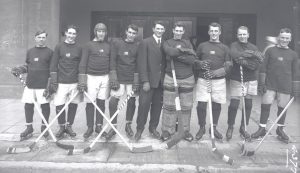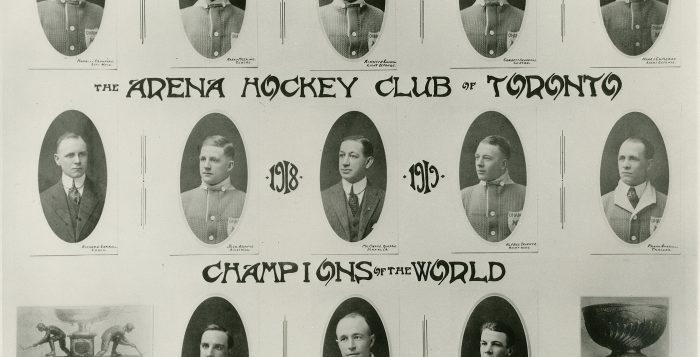This Day in Hockey History – March 30, 1916 and 1918 – Stanley Firsts Part 2
(Image: Toronto Arenas, via Wikimedia Commons)
In 1916 and 1918, the Stanley Cup finals ended on March 30. The former saw the first American team to compete for the Cup, and the latter was the first to feature a team from the newly-formed NHL.
When a PCHA team moved from New Westminster to Portland, Oregon in 1914-15, the Portland Rosebuds became the first American team eligible to challenge for the Stanley Cup. In 1916, they played the Montreal Canadiens of the NHA as the first U.S.-based team to make the finals. The games were held at Montreal Arena and alternated between the eastern rules and the western rules.
The first two games shocked the teams and spectators. Since the first game, held on Monday, March 20, would feature the eastern style and since the Rosebuds had just arrived after such a long journey, everyone predicted the Canadiens would win easily. Instead, Portland’s “Tommy Murray Plays Brilliant Game in the Net” to earn a shutout. Smokey Harris scored in the first period and Charlie Uksila (who replaced him) scored in the second to give Portland the 2-0 victory.
The Rosebuds’ strength coming in and the switch to their western rules combined with the Canadiens playing without Newsy Lalonde and Jack Laviolette, made most bet on Portland to win again on Wednesday, March 22. However, the Portland news admitted, “The Canadiens owe their victory to the wonderful work of their forwards, who outskated the Rosebuds practically throughout the whole evening.” The Montreal Gazette noted that “to [goalie Georges] Vezina goes the greatest share of the credit of scoring the victory.” All of the scoring took place in the first period with Montreal winning 2-1.
The third game, held on Saturday, March 25, featured the biggest fight of the series. The Montreal Gazette tutted that the “free-for-all fight marred a brilliant exhibition.” It began shortly after the third period started with a “cowardly attack of Ernie Johnson’s on Newsy Lalonde.” The police had to assist in breaking up the melee. The Gazette pointed to the subsequent penalties for Portland’s 6-3 loss.
Although the Tuesday, March 28 game had a “disappointingly small attendance,” the “exhibition of hockey furnished was perhaps the most brilliant ever witnessed in a local arena.” The Portland press agreed that the game featured “a regular carnival of scoring and with considerable rough play, as well as spectacular rushes by players on both teams.” The Rosebuds scored the only first-period goal and then twice more in the second. The Canadiens answered with four goals that period. In the third, Portland scored thrice while Montreal only managed one more. As the Gazette succinctly put it, “Twice was the game won and lost by both teams.” In the end, Portland won 6-5 to tie up the series and force a fifth game.
The final Stanley Cup final was held Thursday, March 30 and played by eastern rules “over a sheet of ice that was as nearly perfect as possible which enabled the players to maintain the fast pace at which they started.” As the Portland paper lamented, “There was little to choose between the teams in the matter of skating and stick handling, but the Canadiens had the luck to back up their hard fight and they recaptured the silverware for the east.” The scoring was low with just one goal in the first for Montreal, one goal for Portland in the third, and finally Goldie Prodgers’ winning goal with less than four minutes remaining. The Montreal Gazette celebrated the victory explaining, “In winning this series the Canadiens added to hockey history. They are the first French team to ever hold the coveted trophy.”

Portland Rosebuds, 1914-15, via Wikimedia
Commons
The Canadiens were unable to defend their title in 1917, but that autumn, they broke away from the NHA and helped form the new NHL. Since then, the Montreal Canadiens have won the Stanley Cup 23 more times, the most of all NHL franchises.
The NHL first joined the challenge for the Stanley Cup in 1918. Toronto won the right to represent the NHL with their team sometimes being referred to as the Arenas and at others as the Blues. Eventually, this team became the Toronto St. Patricks then the Toronto Maple Leafs. Their opponents were the PCHA’s Vancouver Millionaires. The best-of-five series was held at Toronto Arena. All odd-numbered games followed the NHL’s six-man rules, while all even-numbered games added the rover position per the Pacific Coast rules.
About 6,000 spectators came out for the opening game on March 20. Despite Vancouver’s unfamiliarity with the NHL rules and the “strangeness of the rink and the heavy ice,” they were able to “break quick and develop speed as they progress. Finished skaters, they can turn in surprisingly small space, rush well and shoot hard, if inaccurately.” Meanwhile, their president, Frank Patrick, sent his brother Lester the summary, “Toronto looks like a good team. Vancouver boys seemed nervous, Cook and Mackay only in form. Officials good. … May have better luck in next game.” Toronto essentially had already won by the time the first period ended, with the final score being 5-3.
The second game was held Saturday, March 23 before a slightly smaller crowd, and the “ice was faster and more to the liking of Vancouver.” According to the press, “When the Blues realized that they were in for a beating, they cast all decency aside and gave the visitors a rough passage. . . . For the greater part of the last period, the Torontos were playing short-handed, owing to penalties.” It was so rough that a “flying puck struck Frank Patrick’s father in the face but he was not hurt seriously.” Still, it took 12 minutes before the first goal, and the Millionaires took off during the final two periods to bring the score up to 6-4. Vancouver’s Mickey Mackay and Toronto’s Alf Skinner both had hat tricks.
By the third game, on Tuesday, March 26, it was obvious the teams were best in their own styles and miserable in the other. Again, Toronto essentially won the game in the first period when they had a 3-0 lead. Skinner, Harry Cameron, and Corbett Denenny all scored twice, while Vancouver only had Cyclone Taylor scoring twice and Ran McDonald once. The final score for Toronto’s victory was 6-3.
The audience must have picked up on the pattern, because the fourth game, on Thursday, March 28 had the “poorest crowd of the series.” Toronto fans were smart not to watch their team only score once at the beginning of what the press called “one of the most uninteresting burlesques that the local sporting public have been asked to watch.” Vancouver proceeded to crush Toronto when Taylor, Barney Stanley, and Lloyd Cook each scored twice while Mackay and McDonald scored one goal each. The Millionaires won handily with 8-1.
With Toronto having won the two NHL-style games and Vancouver having won the two Pacific Coast games, it came down to the fifth game, which would be played by NHL rules. On Saturday, March 30, the large crowd was “wrought up to the highest pitch of excitement.” According to the newspaper recaps, “Vancouver probably had an edge in the initial 20 minutes of the play, but the Blues assumed the aggressive in the next stanza and clearly outplayed and out-lasted the visitors.” Neither team scored until the third period. Skinner scored for Toronto, then Taylor for Vancouver, and finally Denenny scored the winning goal for Toronto. As the Stanley Cup winners, Toronto players would split $350 while Vancouver players received $250 as consolation. In the first appearance by an NHL team in the finals, Toronto became the first NHL team to take home the Cup.
See Part 1 for the history of the 1917 and 1919 Stanley Cup finals.
Additional Sources:
- Brian McFarlane, Brian McFarlane’s History of Hockey (Champaign, Ill.: Sports Publishing Inc., c1997), 12 and 17.
- “Portland Team Here for Series,” Montreal Gazette, 20 March 1916, p. 16.
- “Western Rules in Second Cup Match,” Montreal Gazette, 22 March 1916, p. 12.
- “Rosebuds Defeat the Canadian Champions by Score of 2 to 0,” Oregon Daily Journal, 21 March 1916, p. 12.
- “Canadiens Won Second Cup Match,” Montreal Gazette, 23 March 1916, p. 10.
- “Canadiens Win Second Hockey Match By Point,” Oregon Daily Journal, 23 March 1916, p. 14.
- “Eastern Rules in Third Game,” Montreal Gazette, 25 March 1916, p. 18.
- “Rowdyism Shown by Hockey Players,” Montreal Gazette, 27 March 1916, p. 17.
- “Johnson Not Likely to Play,” Montreal Gazette, 28 March 1916, p. 14.
- “Portland Nosed Out the Canadiens,” Montreal Gazette, 29 March 1916, p. 14.
- “Rosebuds Trim Canadiens 6-5 in Fourth Bout,” Oregon Daily Journal, 29 March 1916, p. 11.
- “Flying Frenchmen Lift Stanley Cup,” Montreal Gazette, 31 March 1916, p. 14.
- “Canadiens Win World Hockey Title in Game,” Oregon Daily Journal, 31 March 1916, p. 10.
- “Toronto Wins First Game of World Series 5 to 3,” Vancouver Sun, 21 March 1918, p. 8.
- Len Brown (of Toronto Mail and Empire), “Millionaires Lose First Stanley Cup Game to Toronto,” Vancouver Daily World, 21 March 1918, p. 10.
- “Vancouver Team Wins Second Hockey Game: Fans Hoot Torontos,” Vancouver Sun, 24 March 1918, p. 24.
- “Toronto Wins,” Vancouver Sun, 27 March 1918, p. 10.
- “Toronto Blues Double Score On The Millionaires in the Third Cup Game,” Vancouver Daily World, 27 March 1918, p. 12.
- “Will Meet Again to Discuss Rules,” Vancouver Sun, 29 March 1918, p. 8.
- “Vancouver Gives Toronto One Record Whaling: Score 8 to 1,” Vancouver Sun, 29 March 1918, p. 10.
- “Vancouver Swamps Toronto 8 to 1” and “Informal Meeting Of Hockey Moguls On Uniform Rules,” Vancouver Daily World, 29 March 1918, p. 12.
- “Toronto Wins 2 to 1 Game Decides Series,” Vancouver Sun, 31 March 1918, p. 22.














